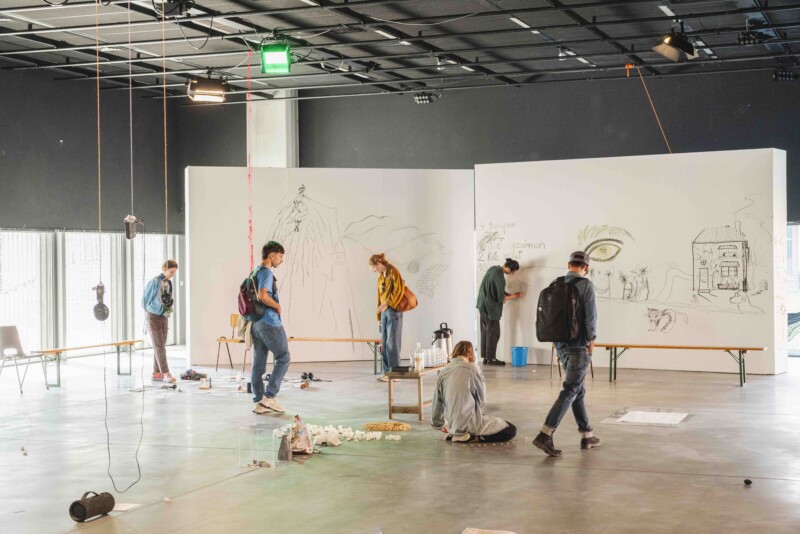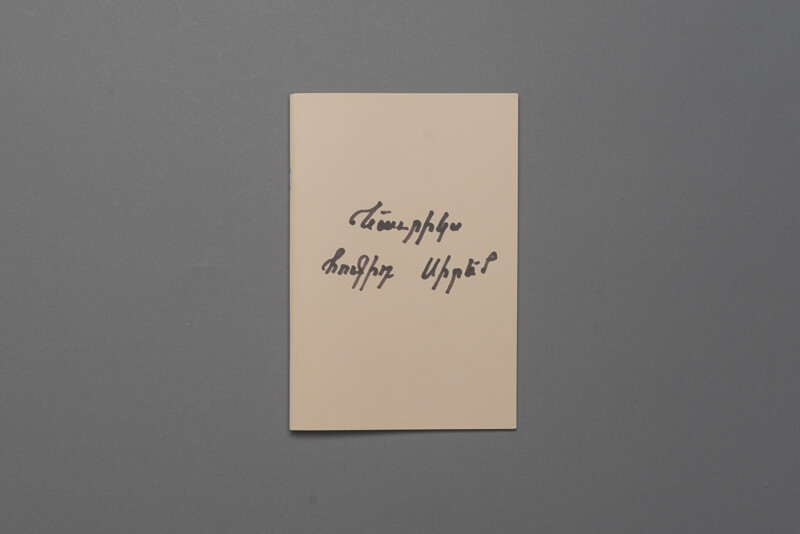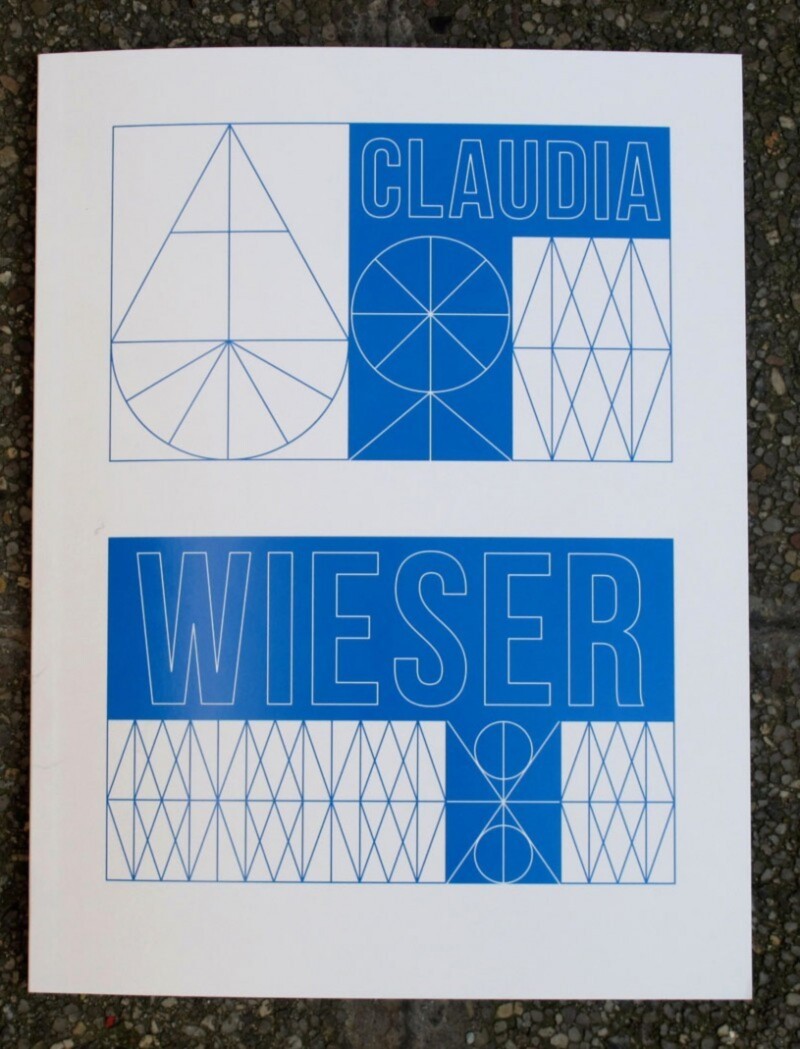WAX (review)
The history of the body is fundamentally human history, for no social practice exists that was not first inscribed upon the body—Silvia Federici1
WAX at KIOSK in Ghent marks Sidsel Meineche Hansen’s first solo exhibition in Belgium, encompassing seven works produced between 2023 and 2024. Through a sophisticated interplay of materiality, mythology, and critique, the exhibition situates itself within the layered history of its venue—a former hospital: anatomical theater, and a Cistercian nunnery. Hansen’s oeuvre interrogates corporeal subjugation as framed by medical science’s ostensible objectivity while addressing contemporary anxieties surrounding digital representation and the ethics of image manipulation through collaborative processes. The architecture of the exhibition space—narrow passageways leading into an open rotunda/theatre—shapes the visitor’s encounter with the works.
In a small room to the right of the entrance, Hansen’s collaborative painting Globe, created with Joanne Robertson, sets the tone. The gestural composition conveys the word “globe,” reflecting the urgency of global crises through personal and emotional investments. The spontaneous nature of the collaboration highlights the tensions between individual agency and collective labor, a recurring theme in Hansen’s practice.
Moving into the rotunda, the chandelier MISSIONARY is hung from the ceiling. Composed of stainless steel and hand-blown glass pendants spelling “MISSIONARY,” this work explores the intersections of sexual repression, religious devotion, and icy fairytale imagery. By referencing the missionary sexual position and Catholic missionary activities, Hansen critiques the entwined control of bodies within religious and societal frameworks. The chandelier subverts its conventional purpose of illumination, instead casting shadows that underscore the eroticized control exerted over female bodies within historical and contemporary power dynamics.
Across the rotunda hanging on the wall, Hook No. 9, a bronze meat hook cast using the lost-wax method. This disquieting yet fragile object symbolizes the ensnarement of bodies through mechanisms such as addiction, industrial slaughter, or psychological trauma. Its duality—both ominous and delicate—reflects Hansen’s broader critique of violence and objectification.

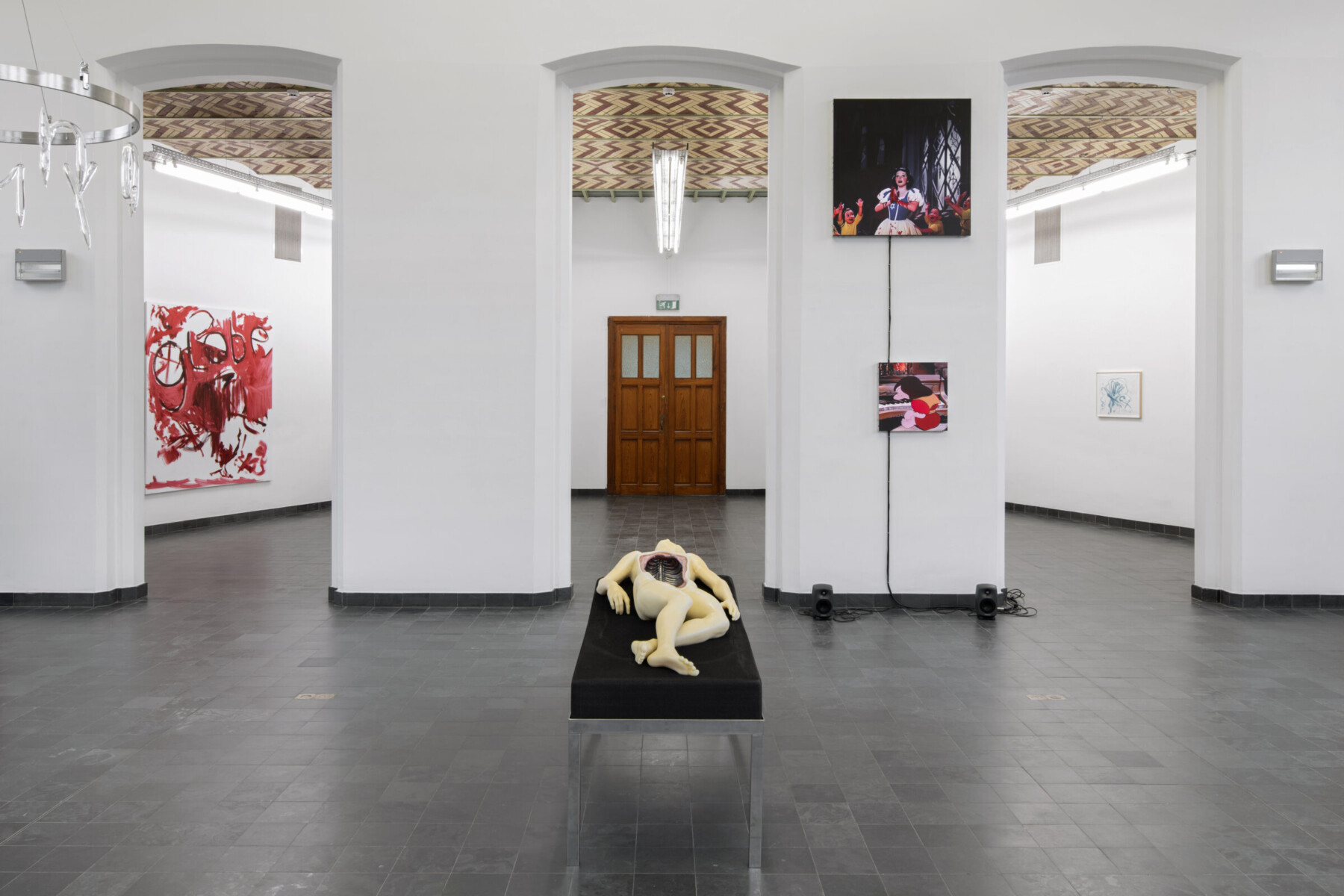
At the core of WAX lies Untitled (Anatomical Venus), a wax and aluminum reclining sculpture situated at the center of the rotunda. Reimagining Clemente Susini’s 18th-century anatomical models, Hansen’s Venus focuses on reproductive organs, including a wax replica of a 3.5-month-old fetus and also a metallic skeleton. Employing a productional model derived from EVA 3.0—a standardized digital 3D figure and its physical-positional referencing to Susini’s La Venerina, the resulting sculpture stripped of most external and internal features, confronts viewers with the relic of voyeurism and objectification inherent to scientific practices. The sculpture’s juxtaposition of wax’s organic fragility and aluminum’s industrial permanence evokes tensions between life and death, the biological and the mechanical, the casting and the cast. This work aligns with Federici’s assertion of a historical battle against the body, wherein mechanization strips it of its organic and social dimensions. As Federici writes: “...capital strives to stabilize its reign, it consciously re-mobilizes the dream of religion: the overcoming of the boundaries of the body, the reduction of the human being to an angellike creature, entirely soul and will”.2
To the left of the Untitled (Anatomical Venus), Kun en Engel falder i Unåde (“Only an Angel Falls from Grace”) and D’s Piano delve into the politics of AI-generated imagery. The former reimagines Snow White’s iconic dress as a bloodstained symbol of trauma, critiquing Israeli state violence and genocide—only from grace falls an angel.
The latter overlays Disney’s Snow White and the Seven Dwarfs' Grumpy with Beethoven’s Moonlight Sonata, creating a jarring dissonance that subverts the original sentimental score.
Hansen’s use of AI-generated visuals evaluates how digital technologies manipulate cultural symbols to serve ideological purposes, resonating with Federici’s critique of capitalism’s dream of control: “a world where images and sounds replace social relations”3, or dare I say, these images and sounds become social relations.
The abstraction of life corresponds to the abstraction of death.4
The "sleeping death"—frozen in time, becomes an interpretative metaphor for the body’s historical objectification, where life is stilled and simplified to serve superficial agendas—both La Venerina (historical) and Snow White (fantastical) are young girls/women who experience death or come close to it, La Venerina as a pregnant young girl, dead-in-waiting for cultural (medical/artistic) observation and manipulation and Snow White as dead-in-waiting for the reviving kiss from the prince (her birth also resulted in the death of her mother).
Hansen’s works challenge these mythic (historical and fantastical) narratives that underpin cultural hierarchies. As Roland Barthes argues in Mythologies, myths and binaries naturalize power structures, obscuring their ideological underpinnings. Hansen’s deconstruction of these narratives invites viewers to interrogate the cultural myths that shape perceptions of sex, gender, power, and death.
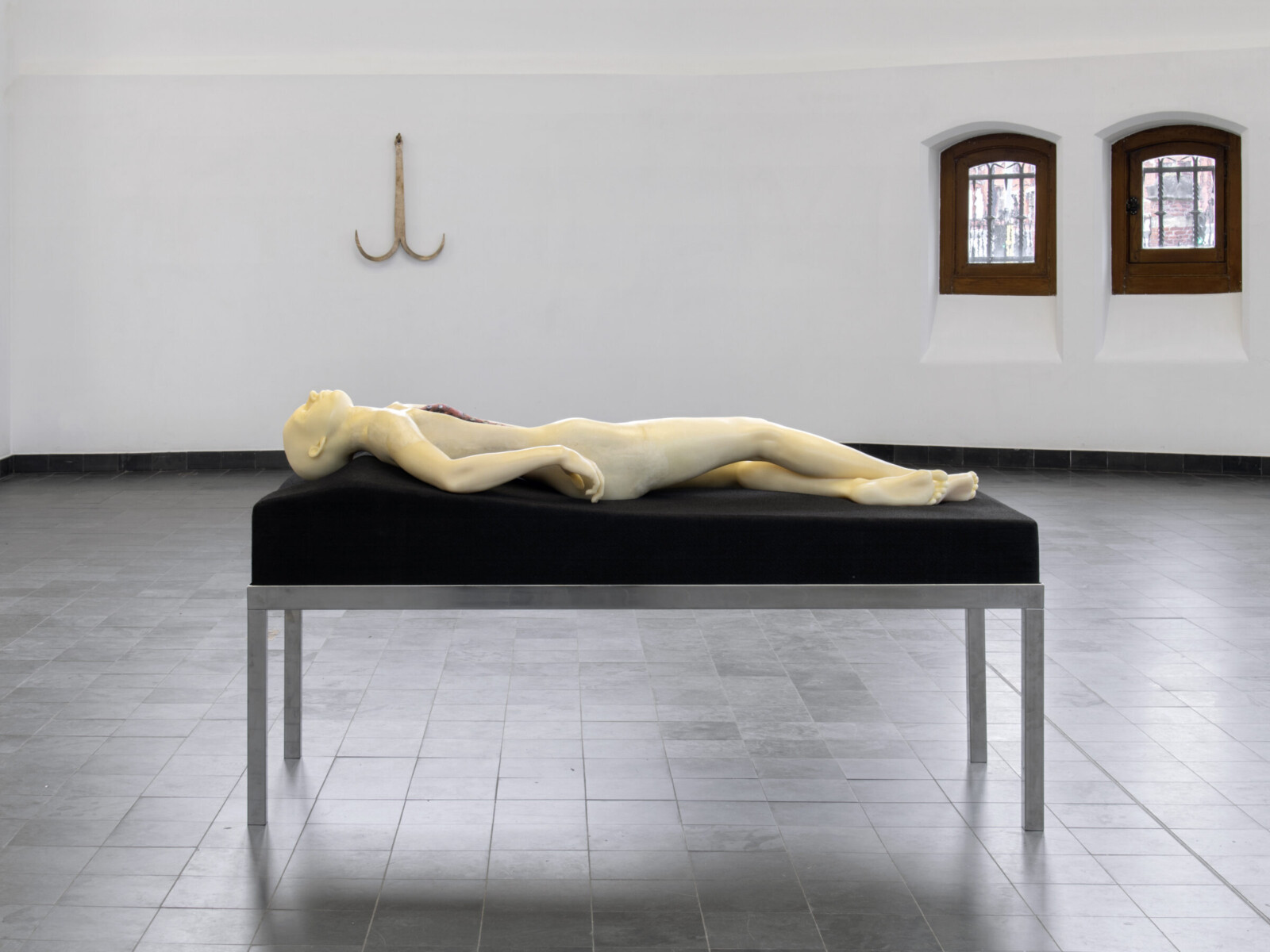
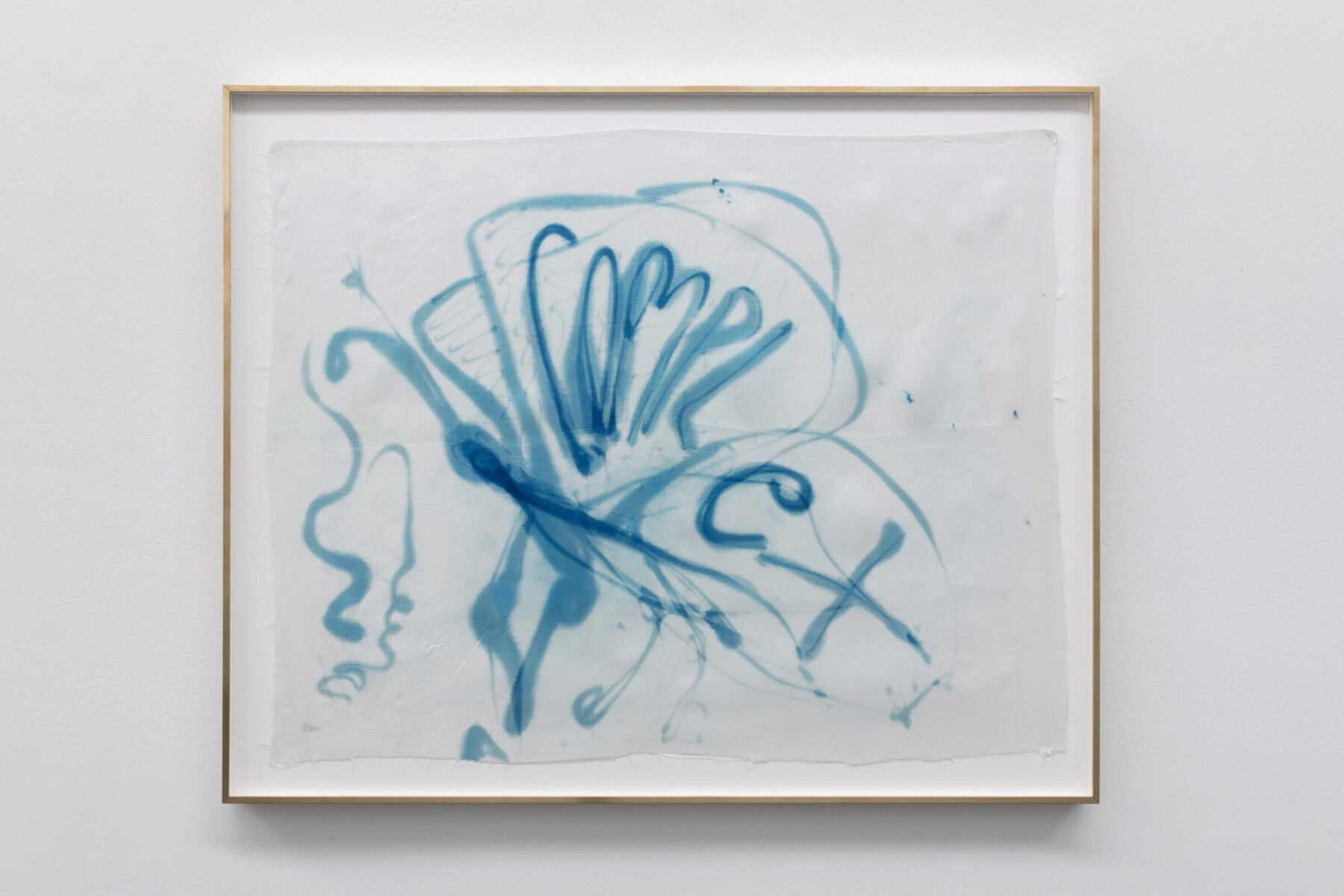
For Barthes, to analyze myth is to “track down...the ideological abuse that is hidden there”.5
In a narrow room near the exhibition’s exit, Butterfly (1), a painting on which the word "complex" is shaped provides a quieter meditation on transformation. Rendered in methylene blue on silk, this delicate work evokes the body’s dual role as a site of personal metamorphosis and escape. Methylene blue’s historical associations with medical experimentation—as a dye (to visualize pathology) and as a treatment deepen the metaphorical resonance of this work.
WAX, action to reconsider how bodies are represented historically, digitally, and artistically, Hansen’s works confront the ethical implications of these portrayals, offering incisive criticisms of objectification. By interweaving historical references, material experimentation, and digital critique, Hansen creates a poignant exploration of where history, biopolitics, and technology converge. In doing so, WAX becomes a powerful commentary on the precarious position of the contemporary body in a world shaped by compound relations to capitalism, knowledge, and mythology.
As Federici observes, the historical battle against the body has produced institutions that redefine our relationships to space, nature, and each other: “the law, the whip, the regulation of sexuality, and myriad social practices”.6
Complexity is the being—action/practice of the human body.
1: Federici, S., & Nicolas-Teboul, L. (2020). Par-delà les frontières du corps : repenser, refaire et revendiquer le corps dans le capitalisme tardif, Editions Divergences p. 131
2: Federici, S., & Nicolas-Teboul, L. (2020). Par-delà les frontières du corps : repenser, refaire et revendiquer le corps dans le capitalisme tardif, Editions Divergences p. 123. This text is highly relevant to technological criticism, as it challenges many of the underlying assumptions of the wired world and the information/knowledge economy. "The old philosopher's stone could convert base metals into gold. Now humans, real estate, social relations are converted into electronic signs carried in an electronic plasma. The dream of magical control has never been exorcised. Perhaps, after all, modern capitalism is a great factory for the production of angels." Yurick, S. (1985). Behold Metatron, the Recording Angel. Autonomedia
3: Ibid., 126.
4: Ibid., 125.
5: Barthes, R., Lavers. A, (1972) “Myth Today.” Mythologies. Trans., New York: Hill and Wang p. 109.
6: Federici, S., & Nicolas-Teboul, L. (2020). Par-delà les frontières du corps : repenser, refaire et revendiquer le corps dans le capitalisme tardif, Editions Divergences p. 132.





















